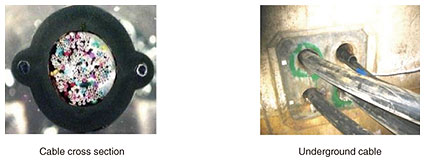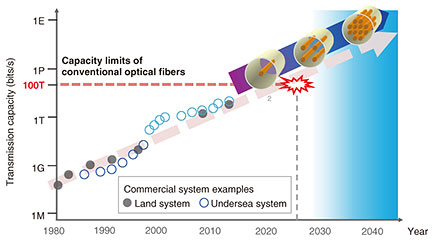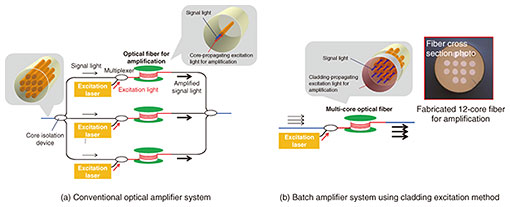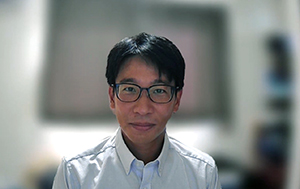 |
|
|
|
|
|
Rising Researchers Vol. 23, No. 2, pp. 8–13, Feb. 2025. https://doi.org/10.53829/ntr202502ri1  Research on Multi-core Optical Fiber, the Foundation of the New Era of High-capacity Communications, and Amplification to Limit Power IncreasesAbstractThe optical fibers that underpin current communications are single-mode optical fibers (SMFs), which have only one core (the path through which light travels). The transmission capacity limit of SMFs is reportedly 100 Tbit/s. Meanwhile, communication volume is expected to continue to increase, and current SMF-based communications may reach its limit between 2030 and 2040. In response to this, development of multi-core optical fibers (MCFs) is underway. We spoke with NTT Distinguished Researcher Taiji Sakamoto, who is researching and developing MCFs with up to 12 cores in a single optical fiber as well as optical amplifiers that limit the increased power consumption that results from an increase in the number of cores. Keywords: single-mode optical fiber, multi-core optical fiber, optical amplifier Aiming for next-generation optical fibers that are at least 10 times faster than the conventional limit—Could you please tell us about your research topic, “research into next-generation optical fibers?” I am conducting research into the next generation of optical fibers that will underpin the high-capacity communications of the era between 2030 and 2040, when much larger volumes of data will likely be in circulation than today. Optical fiber-based optical communications were first adopted in 1985 with the nationwide rollout of a 400-Mbit/s optical relay network, and then optical fiber for access networks was adopted first as high-speed lines for corporations, while for the general public, it began with the adoption of optical fiber for telephone lines to the entrances of apartment buildings. With the spread of broadband Internet, fiber-to-the-home services have been rolled out nationwide since around 2000. Japan has led the world in this trend, with the results of NTT’s research and commercialization providing the foundation. Optical communications are realized through a system in which transmission devices are connected to both ends of an optical fiber. Thanks to various technological advances, the performance of optical communications continues to improve. Meanwhile, with the recent spread of technologies such as artificial intelligence, social media, and video streaming, the amount of data circulating through networks is increasing, and the current optical communication capacity may reach its limit in the 2030s. I am researching next-generation optical fiber to overcome this. The optical fiber I am researching is a high-capacity optical fiber used in long-distance relay link segments. Research into optical fiber is what is known as hardware research, and involves the design, prototyping, and evaluation of actual objects (optical fiber). An optical fiber is shaped like a single glass fiber with a diameter about the thickness of a human hair. Inside it is a path through which light travels called a “core” with a diameter of about 10 μm. This is surrounded by glass containing another component called the cladding, and is further coated to protect the fiber from external pressure, temperature, humidity, etc. The mainstream optical fiber currently in use is single-mode optical fiber (SMF), which has one core in each fiber. Multiple optical fibers are bundled together with reinforcement steel wires, etc., and the whole is covered with a thick coating to form a cable, which is then laid underground or between utility poles (Fig. 1). Now, the transmission capacity, which is the amount of signals that can be transmitted over a single SMF, has been increasing due to technological advances, but it reportedly has a limit of 100 Tbit/s, and we are currently approaching that limit (Fig. 2). Communication volume is expected to continue to increase, and in the 2030s, communication demand per optical fiber may exceed 100 Tbit/s, exceeding the transmission capacity limit. One approach to breaking through this limit is the multi-core optical fiber (MCF), which uses space division multiplexing, arranging multiple cores in a single optical fiber (Fig. 3). For the past 10 years or so, I have been conducting research into MCF, the next generation of optical fiber.
In SMF, the core, which has a diameter of about 10 μm, can only be used in an area of less than 1% of the cross section of the optical fiber. In MCF, the core is placed in the cladding, which accounts for more than 99% of the cross-sectional area of SMF. Due to constraints imposed by infrastructure such as the diameter of the underground conduit through which the cable will be passed, connectors, construction methods, etc., the diameter of each optical fiber must be the same as that of existing SMF, which is 0.125 mm. Optical signals pass through the interface between the core and cladding by repeatedly reflecting the light, but if the fiber is bent significantly, the light will refract and pass through the interface without being reflected. Light leakage from the interface can also occur for other reasons. Within the constraint of a fiber diameter of 0.125 mm, if multiple cores are placed close to each other, signal interference and attenuation will occur due to light leakage. To avoid this, it is necessary to place the cores so that a certain distance between them is maintained (uncoupled MCF). A maximum of four cores can be arranged in a fiber with a diameter of 0.125 mm. However, in view of the future increase in communication volume, at least 10 times as many cores as the existing SMF will be required. Therefore, rather than trying to avoid interference, we assumed that interference would occur and developed a method (coupled MCF) that makes it possible to separate signals at the time of reception by devising a way to cause interference. As a result of further research, we have fabricated a 12-core fiber with 12 cores (Fig. 4).
The key point in the research into coupled MCF was that, unlike the independent communication of each core up until now, it was now necessary to devise a way to cause interference between the cores in order to separate the signals, which necessitated a rethink of optical fiber design technology (methods of arranging the cores, etc.). I remember that this was a big challenge at the beginning of the research, and it was difficult to achieve the expected characteristics when simulating and prototyping. However, repeating trial and error without any idea would only lead to a lot of wasted effort, so we created hypotheses, designed, prototyped, and evaluated the product. By investigating the reasons why the results differed from our hypothesis, we were able to get closer to the correct design. Ultimately, we succeeded in fabricating a prototype 12-core fiber and demonstrating its performance, marking an important step toward realizing next-generation optical fiber with at least 10 times greater capacity. Research on 12-core optical fiber and reducing power consumption of optical fiber for amplification—What are the strengths of your research? Another unique feature of my research is that in addition to researching MCF to improve communication performance, I also aim to reduce power consumption. When an optical signal is passed through an optical fiber, the intensity of the light is attenuated and the optical signal cannot transcend long distances. For this reason, amplifiers are installed every several dozen kilometers in an actual optical fiber network, enabling communications over distances of several thousand kilometers, such as undersea networks connecting continents. Amplification is performed for each signal flowing through each core, so expanding communication capacity using MCF will require amplifiers for each additional core, which will increase power consumption accordingly. In recent years, energy consumption has become a social issue, such as in relation to protecting the global environment, so research into reducing the power consumption of amplifiers is also necessary. Optical amplifiers use optical fiber because they “amplify light directly” without converting it into electricity or any other form. However, optical fiber for optical amplification is a different type of optical fiber from optical fiber used for communications, and it amplifies the signal light by injecting another light, which acts as an energy source, into a core to which a special material has been added. The other light generated in this process is called excitation light, and the increase in power consumption caused by the laser that generates this excitation light is a problem. However, just as communication channels can be upgraded to MCF, by upgrading the amplifier optical fiber to MCF as well, it is possible to amplify all cores at once (cladding excitation method). In addition to creating a 12-core fiber for communications, we have already fabricated a 12-core optical fiber for amplification and demonstrated that it can achieve amplification with less power consumption than the conventional method of combining 12 amplifiers (Fig. 5).
Therefore, I believe that my research can contribute not only to research into next-generation optical fibers capable of transmitting large volumes of data, but also to reducing power consumption, which leads to the reduction of carbon dioxide emissions, a social issue. —Could you tell us about the current results of this research and its future prospects? Recently, in collaboration with other companies, we have been using the fibers we have fabricated to demonstrate the performance of communication systems, including the world’s first long-distance transmission experiment of over several thousand kilometers using a 12-core fiber. We are also conducting transmission experiments by putting the 12-core fiber into a cable and laying the cable in a service tunnel (a tunnel communication civil engineering facility that can accommodate a large amount of underground communication cables) on the laboratory ground as well as by constructing a facility that simulates an outdoor environment (overhead sections such as between utility poles) and laying the cable in the facility. However, in the current transmission experiment verification, the optical amplification section uses the conventional method of amplifying the signal using a number of amplifiers equal to the number of cores. Moving forward, we will use MCF amplifiers to verify the balance of transmission capacity, communication distance, and low power consumption. We believe it is important not only to demonstrate the performance of optical fiber alone, but also to proceed with our research in tandem with other peripheral technologies. We hope to establish this technology by 2030, when the Innovative Optical and Wireless Network (IOWN), which aims to achieve high capacity and low power consumption, will be implemented in the real world.
Consider compatibility with existing and peripheral technologies—What is your research challenge or a problem you are trying to solve? Optical fiber communication channels have a very long service life and, once installed, can be used for decades, so there are not many opportunities to adopt new technologies. I have been researching optical fibers since joining the company, but I have not experienced the large-scale adoption of new optical fibers. Recently, we have begun to see moves to move forward with the adoption of MCF, which gives me hope as an optical fiber researcher. However, the barriers to commercialization are high, and there are many factors to consider, including construction, operation, and maintenance, for communication infrastructure that is designed to remain unchanged for long periods of time once installed. Therefore, when proceeding with research, it is very important to consider compatibility with conventional and peripheral technologies. A communication system cannot be built using optical fiber alone; it requires a combination of other technologies, such as transmitters and receivers, optical amplifiers, and other devices. It cannot be developed according to optical fiber alone. For example, it is assumed that the thickness of optical fiber used for communications will remain the same as before. If its thickness were to change, it would have a major impact on the cable thickness and manufacturing method, and all of the traditional technologies and standards that have been passed down from researchers of the past would change, which would undermine the sustainability of the infrastructure for telecommunications carriers. Generally, one might imagine that research involves working on innovative things, but in the field of optical fiber research and development, it is difficult to strike a balance between what can and cannot be changed, and it is not enough to simply have high performance. For example, even if we were to thicken the fiber and develop a 100-core fiber, it would not be possible to commercialize it. This is because communication itself does not operate on a single device such as a home appliance, but rather requires multiple devices to be connected and work together, so it is important for telecommunications carriers to consider compatibility with older networks and devices that already exist. However, if we are bound by conventional thinking, we will not be able to achieve dramatic improvements in performance. As an optical fiber researcher, it is difficult to strike a balance between maintaining consistency with conventions and wanting to break away from that framework and do something innovative. I believe that there is accumulated knowledge and technology in the world of optical fiber that must be safeguarded, and this is something that our group values. Because the 12-core fiber uses the unprecedented concept of “mixing signals,” I think it will become necessary to consider new standards that have not ever been considered. We are considering various options, such as a 4-core fiber that is compatible with existing technology and a 12-core fiber that improves performance by more than an order of magnitude, and we hope to overcome the issues we are considering with an eye to commercialization. —Finally, do you have a message for researchers, students, and business partners? It is rare even from a global perspective for a telecommunications carrier to place such importance on research and development and to aim to develop the next generation of a system, and I believe this is something that is unique to NTT. I personally really feel the company’s intention to foster researchers, and there is a lot of freedom in considering research topics, making it a place where you can think for yourself and express your individuality. At NTT, it is common for employees to be transferred to other departments or even to subsidiaries, but because I have continued my research at the same research institute, I feel that I am allowed to do the research I want to do. On the other hand, because I have no experience outside of research, I lack a practical perspective, and in that respect I need support from those around me. When I look around me, I see that there are many people with a wide range of experience and knowledge, and I feel that it is a well-rounded organization. Although in some ways I may feel that my experience solely focused on research is a disadvantage, it seems that in a sense I have become someone who is well suited to a research institute, which shows the broad-mindedness of the institute. Because optical fiber is only one element in a communication system, discussions with business partners engaged in research and development in related fields are very important, and I would like to continue to collaborate proactively. Telecommunication networks are important infrastructure. In order to achieve their long-term, sustainable development, we would like to hear your honest (even harsh) opinions, and move forward while identifying what is sensible. Honestly, I think I’m lucky and privileged. I also think it’s important to believe you’re privileged. I want students and young researchers to cherish the feeling that they are doing what they want to do and the excitement that comes with it. I’ve heard that a person’s abilities can rise or fall several times over depending on whether or not they are excited about their work. You might think that this means you should only do the work you want to do, but I think it’s all about whether or not you can acquire the ability to get excited about a variety of things. As you work on various tasks, you may find yourself engaging in negative thinking, but if you can stay positive at those times, you will eventually be able to use those experiences as your own. Although there are difficulties and anxieties associated with conducting research while being bound by the mission and circumstances of a corporate research institute as well as my own wishes, I fundamentally enjoy my research work. I am looking forward to the opportunity to do exciting work together. ■Interviewee profileTaiji Sakamoto completed his master’s degree in electrical engineering and information science at the Graduate School of Engineering, Osaka Prefecture University in 2006. In the same year, he joined Nippon Telegraph and Telephone Corporation (NTT). He completed his doctoral studies at the same university and obtained a Ph.D. in engineering in 2012. To date, he has been engaged in research into next-generation optical fibers for high-speed, high-capacity communications. From 2012 to 2023, he was involved in international standardization efforts at the International Telecommunication Union - Telecommunication Standardization Sector (ITU-T) and the International Electrotechnical Commission (IEC). He was a part-time lecturer at the Faculty of Science and Engineering, Yokohama National University in 2022 and associate editor of the Journal of Lightwave Technology published by IEEE in 2024. |
|














